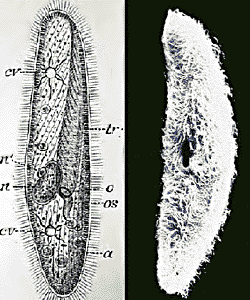Introduction to the Ciliata


The Ciliata, or Ciliophora, includes about 7000 known species of some of the most complex single-celled organisms ever. They derive their name from the Latin word for "eyelash," which describes the appearance of many ciliates quite well: some or all of the surface of a ciliate is covered with relatively short, dense hairlike structures, the cilia, which beat to propel the ciliate through the water and/or to draw in food particles.
Ciliates include some of the largest free-living protists; a few genera may reach two millimeters in length. They are abundant in almost every environment with liquid water: ocean waters, marine sediments, lakes, ponds, and rivers, and even soils. Because individual ciliate species vary greatly in their tolerance of pollution, the ciliates found in a body of water can be used to gauge the degree of pollution quickly.
For more information, visit the Ciliate Homepage.
The electron micrograph of Paramecium on this page was provided by BIODIDAC.
The 19th-century zoologist Rudolph Leuckart created a classic series of wall charts, now available on-line from the Marine Biological Laboratory at Woods Hole, Massachusetts. Several of his images of ciliates are available; look under "Infusoria," an older name for the Ciliata.


